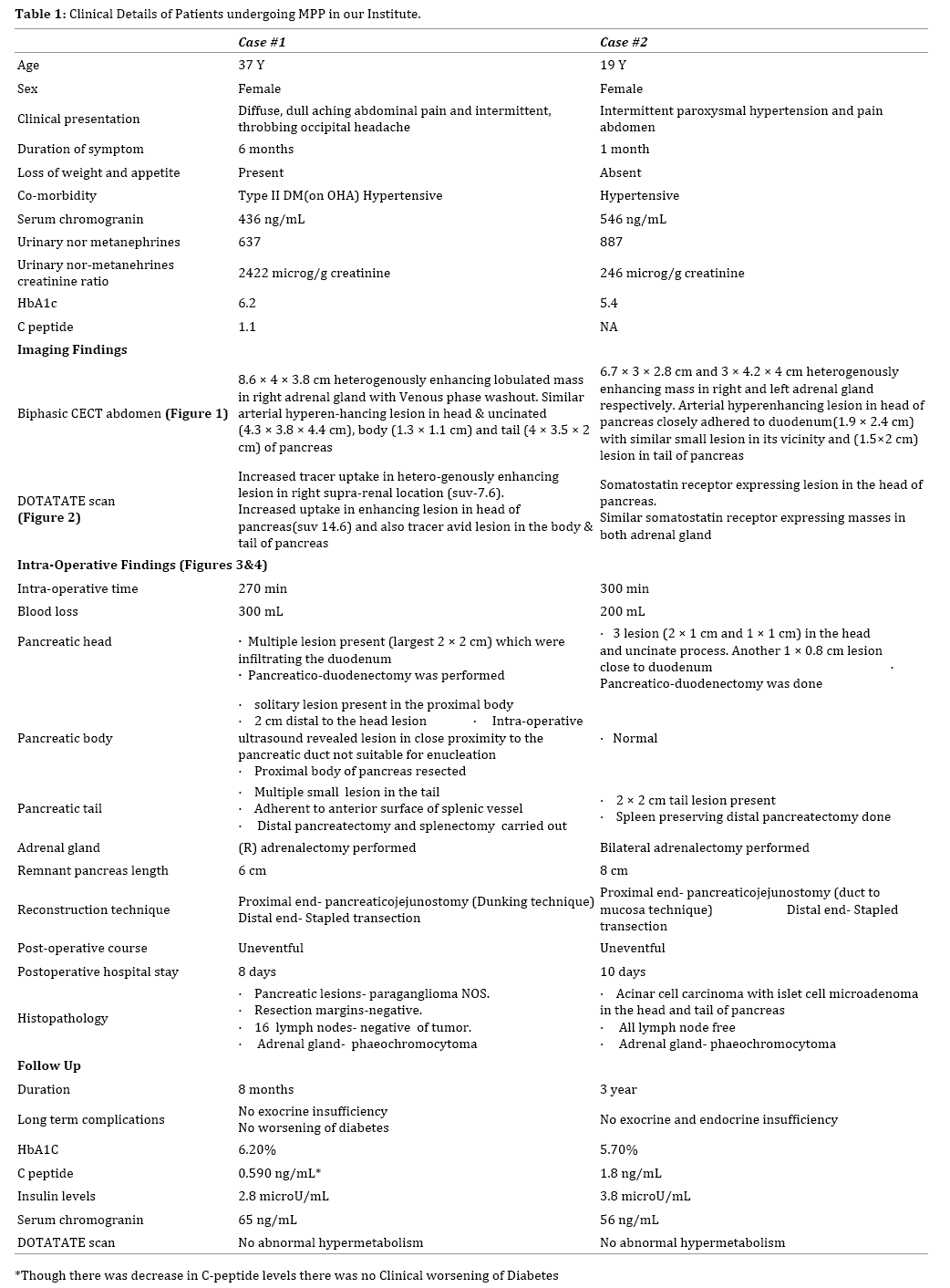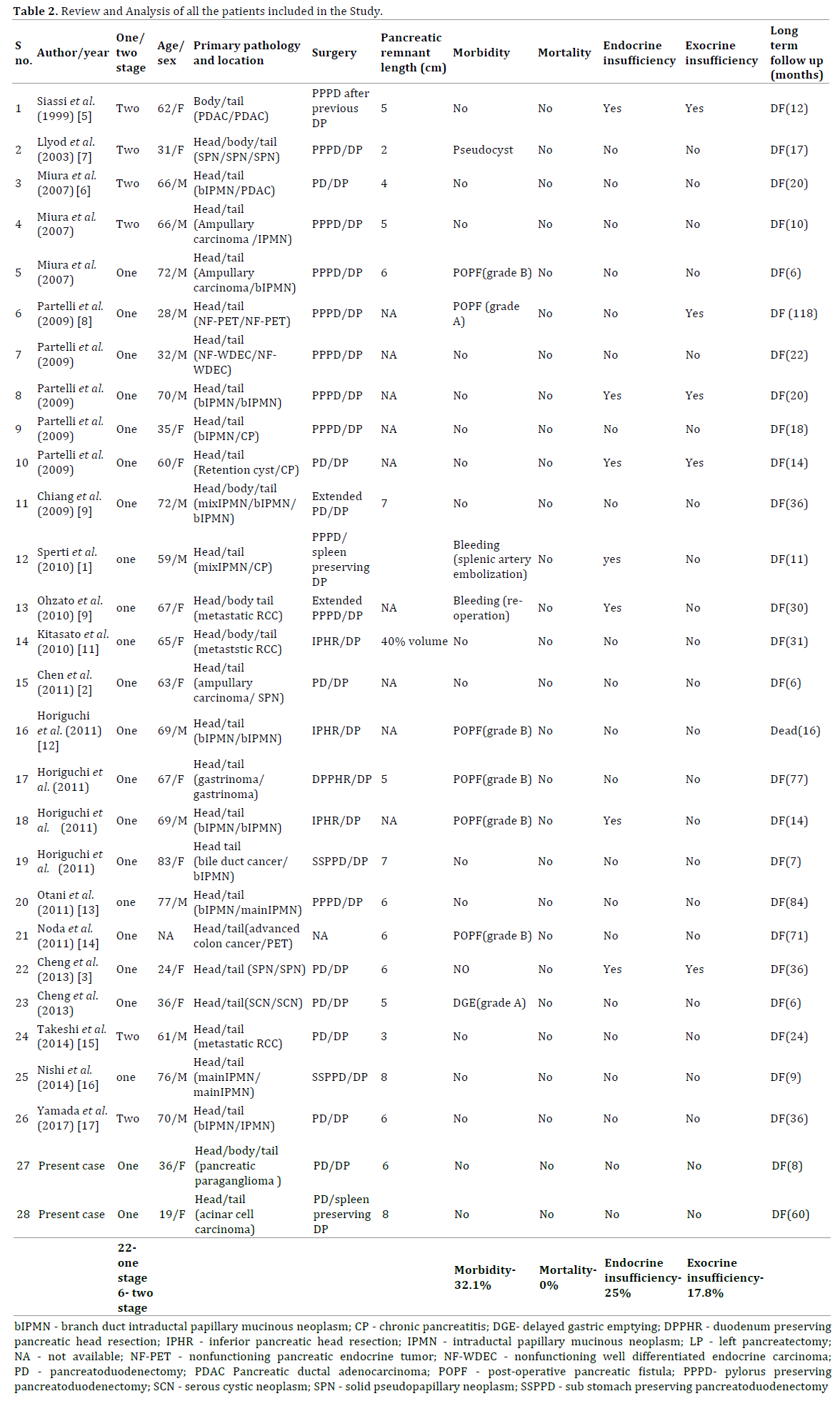Review Article - (2018) Volume 19, Issue 4
Vikas Gupta1, Vikash Moond1, Santhosh Irrinki1, Ashwini Sood2, Ajay Gulati3, Amanjit Bal4, KimVaiphei4, Saroj K Sinha5, Rakesh Kochhar5
Department of General Surgery1, Nuclear Medicine2, Radiodiagnosis3, Pathology4 and Gastroenterology5, Postgraduate Institute of Medical Education and Research, Chandigarh 160012, India
Received March 04th, 2018 - Accepted June 25th, 2018
Background Multicentric pancreatic neoplasm offers a unique challenge to the surgeon with respect to the surgical procedure to be performed. Traditionally total Pancreatectomy was considered as the standard treatment in these patients. But due to the inevitable pancreatic state associated with the procedure alternative parenchyma sparing pancreatic surgeries have evolved as effective options. Middle preserving pancreatectomy is one such option when the pancreatic body is unaffected by any pathology. Methodology Two patients with multi centric pancreatic tumors who underwent middle preserving pancreatectomy for suspected neuroendocrine tumor were reviewed. We have also reviewed the English literature and found 26 cases of middle preserving pancreatectomy. The demographic, intra-operative and postoperative morbidity, mortality and the risk of pancreatic insufficiency associated with the procedure were evaluated. Results The overall morbidity was 32.1% (9/28), pancreatic fistula rate 17.8% (5/28), risk of re-operation estimated as 3.5% (1/28). There was no perioperative mortality. . The rate of endocrine and exocrine insufficiency to be 25% (7/28) and 17.8% (5/28), respectively. The reported length of remnant pancreas has varied between 2cm to 8 cm. There has been no reported case of pancreatic remnant necrosis and disease recurrence in the remnant pancreas on follow up. Conclusion Middle preserving pancreatectomy is a feasible, safe and effective alternative in carefully selected patients with benign or low grade multicentric pancreatic neoplasms.
Pancreatic Neoplasms; Paraganglioma
Multicentric pancreatic neoplasm though rare can be encountered in patients with neuroendocrine tumors, cystic neoplasms, synchronous pancreatic adenocarcinoma or metastatic lesion from other organs [1]. These lesions offer a unique challenge to the surgeon with respect to the surgical procedure to be performed. The balance between radical resection and post-operative quality of life has to be considered. Conventionally total Pancreatectomy was the surgical option for multi focal pancreatic neoplasm, however it is associated with impaired functional outcome in terms of long term exocrine and endocrine insufficiency [2]. Parenchyma preserving pancreatic resection for multiple and low grade lesion has been described to circumvate the functional consequences associated with total pancreatectomy. These may vary from enucleation to segmental resection to preservation of small pancreatic segment. Middle preserving pancreatectomy is an attractive option in such patients [3]. Ever since its first description in 1999, only 26 cases has been reported in the English literature so far. Middle Preserving Pancreatectomy is a rare surgical procedure mainly due to lack of suitable cases. We hereby report our experience with two cases of middle preserving pancreatectomy performed over a period of seven years.
The present study describes two patients who underwent Middle preserving Pancreatectomy for multi centric pancreatic neoplasm. From January 2011 to December 2017 two patients undergoing middle preserving pancreatectomy were reviewed retrospectively. Demographic, biochemical, radiological, operative and follow up data were retrieved. During the study period a total of 308 pancreatic resection were performed which included 276 pancreatico-duodenectomies, 27 distal pancreatectomies and 3 middle pancreatectomies. The incidence of Middle Preserving Pancreatectomy was 0.6%
Both patients had almost identical presentation. Both were young females with clinical presentation of intermittent paroxysmal hypertension along with elevated urine and serum catecholamine level. One of them was a diabetic (Table 1).

On imaging both had hyper-vascular lesion in the head and uncinate process of pancreas and similar lesion in the tail. One of them had similar nodule in the pancreatic body as well. Both had adrenal lesions suggestive of pheochromocytoma; one of the patients had bilateral disease. Both the patients underwent Middle Preserving Pancreatectomy and Adrenalectomy and both had an uneventful recovery (Figures 1 and 2).
Technique of Middle Preserving Pancreatectomy
After a rooftop incision, the peritoneal cavity was carefully explored and the pancreas was exposed. A standard Antrum preserving pylorus ring excisionpancreaticoduodenectomy was performed towards the head lesion. For the distal lesion, care was taken to preserve the dorsal pancreatic artery. A spleen-preserving distal pancreatectomy with careful dissection of the splenic vessels was done in one patients, while the other one with a large lesion impinging upon the splenic hilum, concomitant splenectomy was performed. In the patient where splenectomy was performed, the splenic vessels were ligated at the level of distal pancreatic transection. Both proximal and distal resection margins were confirmed free of malignancy on frozen section. The distal pancreatic stump was closed using a linear stapler. Care should be taken in leaving at least 5 cm of pancreatic remnant which was 6 and 8cm in the two index cases. The proximal end of the pancreatic stump was anastomosed end-to-side to a Roux en-Y jejunal loop. An end-to-side hepaticojejunostomy and gastrojejunostomy were performed in same order over a single jejunal loop. Figures 3 and 4 shows the end result of the surgical procedure.
Literature Search Strategy
A PubMed search was made using the key words Middle preserving pancreatectomy, Center preserving Pancreatectomy, Multicentric pancreatic lesions, Parenchyma preserving Pancreatectomy and the resultant articles dating between 1999 to December 2017 were scrutinized and 16 full text articles were systematically reviewed in the present analysis. Out of the 16 articles reviewed, four were case series and remaining 12 were single case reports.
Literature Analysis
In the present study a total of 28 patients data were retrieved and analysed (including two from present study). For patients operated after 2007, the complications such as pancreatic fistula, delayed gastric emptying and post pancreatectomy haemorrhage were classified in accordance with the ISGPS definitions [4]. The mean age of the study group was 56.85 years (19-83 years), female to male ratio was 1:1.07. In the present review the most common indication for Middle Preserving Pancreatectomy was Intraductal Papillary Mucinous Neoplasm (10) and other indications were Pancreatic Endocrine tumors (4), Solid Pseudopaillary neoplasms (3), Metastatic Renal Cell carcinoma (3), chronic pancreatitis (3), pancreatic ductal adenocarcinoma (2), serous cystic neoplasm (1). 22 patients underwent one stage Middle Preserving Pancreatectomy while the remaining six patients underwent the surgery in two stages. The mean length of pancreatic remnant to be 5.5 cm (2-8 cm). In the present analysis we found the overall morbidity to be 32.1% (9/28), Pancreatic fistula rate was 21.4% (6/28) of which 7.14% (2/28) were grade A and 14.2% (4/28) was grade B. One patient had grade A delayed gastric emptying, while 2 patients had postoperative haemorrhage which was managed by coil embolization of the splenic artery in one and surgical reexploration in another. There have been no reports of peri-operative mortality or necrosis of the remnant pancreas till now. We found the rate of endocrine and exocrine insufficiency to be 25% (7/28) and 17.8% (5/28) respectively (Table 2).

Siassi et al. in 1999 first described a two staged middle preserving pancreatectomy in a patient with metachronous pancreatic adenocarcinoma who previously underwent distal pancreatectomy [5]. In 2007 Miura et al. reported first single stage Middle Preserving Pancreatectomy with successful outcome [6]. Ever since only 26 cases have been reported [7, 8, 9, 10, 11, 12, 13, 14, 15].
Middle preserving pancreatectomy is a rare surgical procedure, mainly due to lack of suitable cases. Middle preserving pancreatectomy should be avoided in patient with pancreatic ductal adenocarcinoma due to inability to perform proper lymphadenectomy and compromise of resection margins [16]. Middle preserving pancreatectomy has been considered preferable in patients with benign, borderline or low grade malignancies with multicentricity. MPP should be converted to an oncologically appropriate operation if inadequate tumor resections are encountered intraoperatively (Figure 5).
Middle preserving pancreatectomy has two potential sources of pancreatic fistula - pancreato-intestinal anastomotic site and stapled distal end of pancreatic remnant. So, theoretically can be considered to be at a higher risk of pancreatic fistula and perioperative morbidity. Perioperative morbidity and mortality associated with pancreatoduodenectomy and distal pancreatectomy are 38-44%, 1-4% and 13-54%, 0-4% mrespectively [17, 18, 19, 20, 21] which is comparable to Middle Preserving Pancreatectomy. In a recent metaanalysis, total pancreatectomy was associated with an overall morbidity and mortality of 31.1-57.1% and 1.6- 9.2% respectively with inevitable exocrine and endocrine insufficiency [22].
Dorsal pancreatic artery is the major supply to the pancreatic remnant and care should be exercised to preserve it [16]. This can be achieved by performing careful lymphadenectomy at the level of celiac and splenic artery. Both the patients in the present study had an uneventful recovery; this was probably due to the better preservation of blood supply of pancreatic remnant.
There are no consensuses regarding the optimal length of pancreatic remnant to prevent pancreatic insufficiency. Clinically significant pancreatic insufficiency results from80-90% loss of pancreatic parenchyma [23]. To prevent pancreatic insufficiency Miura et al. proposed preservation of at least 25% pancreatic parenchyma [6]. Yasuda et al. analyzed the volume of middle portion of pancreas to be 25% of the gland based on CT pancreatic volumetric [24]. Theoretically middle preserving pancreatectomy should preserve enough pancreas to preclude development of exocrine and endocrine insufficiency. The length of pancreatic remnant predicted to prevent exocrine and endocrine insufficiency has been estimated to be at least 5-6 cm, as this length approximates to about 35-40% of the gland. Moreover middle preserving pancreatectomy preserves glucagon secreting alpha cells located mainly in the body of pancreas and reduce risk of brittle diabetes [1]. In our analysis we found even the patient with small remnant pancreas (2 cm) did not develop pancreatic insufficiency at 17 months follow up.
Pancreatic pathology involving the head and tail definitely has the potential of involving the pancreatic body. There is a risk of residual or recurrent disease in the remnant pancreas. In order to avoid the recurrence in the remnant pancreas after MPP, appropriate candidates should be selected through careful preoperative evaluation of malignant potential, and intraoperative frozen section analysis of the two resection margins. Furthermore, intraoperative ultrasound would be helpful to identify all of the lesions and to confirm that the remnant was disease free. There have been no reports of disease recurrence in the remnant pancreas after middle preserving pancreatectomy. However the patient should be kept on regular follow up to detect early recurrence.
Concluding, middle preserving pancreatectomy is a feasible, safe and effective alternative in carefully selected patients with benign or low grade multicentric pancreatic neoplasms. The procedure can be performed with acceptable morbidity and no mortality with a good long term functional outcome.
There are no conflicts of interest.